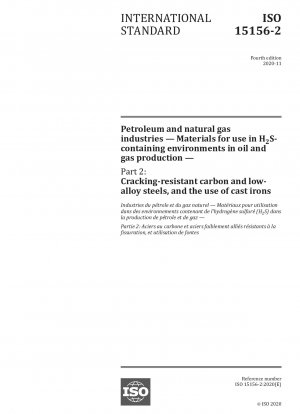ISO 15156-2:2020
Petroleum and natural gas industries — Materials for use in H2S-containing environments in oil and gas production — Part 2: Cracking-resistant carbon and low-alloy steels, and the use of cast irons
- Standard No.
- ISO 15156-2:2020
- Release Date
- 2020
- Published By
- International Organization for Standardization (ISO)
- Latest
- ISO 15156-2:2020
- Scope
- This document gives requirements and recommendations for the selection and qualification of carbon and low-alloy steels for service in equipment used in oil and natural gas production and natural gas treatment plants in H2S-containing environments, whose failure can pose a risk to the health and safety of the public and personnel or to the environment. It can be applied to help to avoid costly corrosion damage to the equipment itself. It supplements, but does not replace, the materials requirements of the appropriate design codes, standards or regulations. This document addresses the resistance of these steels to damage that can be caused by sulfide stress cracking (SSC) and the related phenomena of stress-oriented hydrogen-induced cracking ISOHIC) and soft-zone cracking (SZC). This document also addresses the resistance of these steels to hydrogen-induced cracking (HIC) and its possible development into stepwise cracking (SWC). This document is concerned only with cracking. Loss of material by general (mass loss) or localized corrosion is not addressed. Table 1 provides a non-exhaustive list of equipment to which this document is applicable, including exclusions. This document applies to the qualification and selection of materials for equipment designed and constructed using load controlled design methods. For design utilizing strain-based design methods, Annex A lists SSC-resistant carbon and low alloy steels, and A.2.4 includes requirements for the use of cast irons. This document is not necessarily suitable for application to equipment used in refining or downstream processes and equipment. Table 1 — List of equipment This document is applicable to materials used for the following equipment Exclusions Drilling, well construction and well-servicing equipment Equipment exposed only to drilling fluids of controlled compositiona Drill bits Blowout preventer (BOP) shear bladesb Drilling riser systems Work strings Wireline and wireline equipmentc Surface and intermediate casing Wells, including subsurface equipment, gas lift equipment, wellheads and christmas trees Sucker rod pumps and sucker rodsd Electric submersible pumps Other artificial lift equipment Slips Flow-lines, gathering lines, field facilities and field processing plants Crude oil storage and handling facilities operating at a total absolute pressure below 0,45 MPa (65 psi) Water-handling equipment Water-handling facilities operating at a total absolute pressure below 0,45 MPa (65 psi) Water injection and water disposal equipment Natural gas treatment plants — Transportation pipelines for liquids, gases and multiphase fluids Lines handling gas prepared for general commercial and domestic use For all equipment above Components loaded only in compression a See A.2.3.2.3 for more information. b See A.2.3.2.1 for more information. c Wireline lubricators and lubricator connecting devices are not excluded. d For sucker rod pumps and sucker rods, reference can be made to NACE MR0176.
ISO 15156-2:2020 Referenced Document
- ISO 10423 Petroleum and natural gas industries — Drilling and production equipment — Wellhead and tree equipment*, 2022-03-08 Update
- ISO 15156-1:2020 Petroleum and natural gas industries — Materials for use in H2S-containing environments in oil and gas production — Part 1: General principles for selection of cracking-resistant materials
- ISO 15156-3 Petroleum and natural gas industries — Materials for use in H2S-containing environments in oil and gas production — Part 2: Cracking-resistant carbon and low-alloy steels, and the use of cast irons
- ISO 6892-1 Metallic materials — Tensile testing — Part 1: Method of test at room temperature
- NACE TM0284 Evaluation of Pipeline and Pressure Vessel Steels for Resistance to Hydrogen-Induced Cracking (Item No. 21215)
- NACE TM0316 Four-Point Bend Testing of Materials for Oil and Gas Applications
ISO 15156-2:2020 history
- 2020 ISO 15156-2:2020 Petroleum and natural gas industries — Materials for use in H2S-containing environments in oil and gas production — Part 2: Cracking-resistant carbon and low-alloy steels, and the use of cast irons
- 2015 ISO 15156-2:2015 Petroleum and natural gas industries - Materials for use in H2S-containing environments in oil and gas production- Part 2:Cracking-resistant carbon and low-alloy steels, and the use of cast irons
- 2009 ISO 15156-2:2009 Petroleum and natural gas industries - Materials for use in H<(Index)2>S-containing environments in oil and gas production - Part 2: Cracking-resistant carbon and low-alloy steels, and the use of cast irons
- 2005 ISO 15156-2:2003/Cor 1:2005 Petroleum and natural gas industries - Materials for use in H<(Index)2>S-containing environments in oil and gas production - Part 2: Cracking-resistant carbon and low alloy steels, and the use of cast irons; Technical Corrigendum 1
- 2003 ISO 15156-2:2003 Petroleum and natural gas industries - Materials for use in H<(Index)2>S-containing environments in oil and gas production - Part 2: Cracking-resistant carbon and low alloy steels, and the use of cast irons
